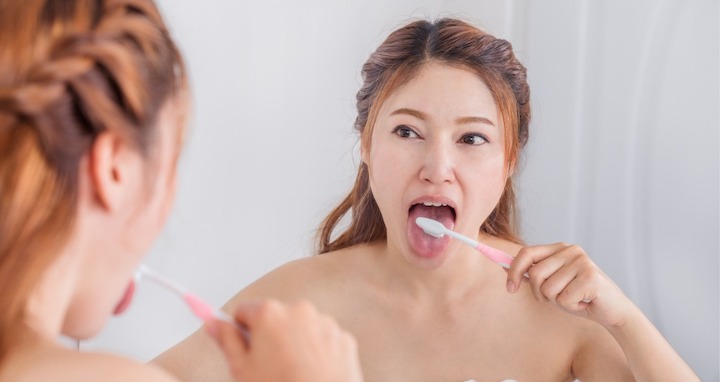
Tongue brushing or scraping has been practised for thousands of years in the Eastern world despite being relatively new in the West. But will cleaning your tongue improve your oral health?
Most people clean their tongue to ensure a fresh breath and to remove any white coating that may be present. The tongue should be a healthy pink colour. A white coating can be a sign of some medical issues. But if you’re healthy, a white tongue is most likely a sign of dehydration, fever or a dry mouth. A white tongue may also cause a stinky breath and bad taste because the white coating is made up of bacteria and dead cells.
Is Tongue Cleaning Necessary?
Tongue cleansing has become a popular addition to many people’s dental hygiene routine. Research into the benefits of tongue cleaning are mixed. Bacteria multiplies quickly so cleaning your tongue twice daily is recommended if you’re trying to reduce the bacteria load. This said, there is no doubt that cleaning your tongue can reduce the bacteria from the surface of the tongue, but the question is how much of an impact it has on reducing bad breath and improving oral health.
How to Clean your Tongue
There are a few methods to choose from when considering how you’ll clean your tongue.
Tongue Brushing
The quickest and most common way to clean your tongue is with your toothbrush. While your brush is already in your mouth busy cleaning your teeth and gums, you can use your brush to clean your tongue too. After finishing your teeth, place a little more toothpaste on your toothbrush. Start at the back of the tongue, and use a firm pressure to move in back and forth motions toward the tip of your tongue.
A mistake is to assume that brushing your tongue will make up for a quick pass over your teeth and gums. Proper tooth brushing is needed to remove bacteria and plaque from these. An adequate scrubbing protects teeth from cavities and gums, from gingivitis and gum disease. Only after properly brushing your teeth, should you then proceed to brushing your tongue.
Tongue Scrapers
Tongue scrapers are usually a U-shaped plastic or metal object with two handles, used as an oral hygiene tool to clean the coating on the upper surface of the tongue. The user places the scraper at the back of the tongue and with gentle pressure moves the scraper towards the tongue’s tip. This process is repeated for a second or third time. The scraper should have no sharp edges, and be easy to clean thoroughly after each use to avoid re-introducing bacteria into your mouth when using it again. Some tongue scrapers are flavoured. Similar to toothpaste, the scraper gives the tongue a clean, fresh feeling after use.
Natural Tongue Cleaners
A toothbrush and toothpaste or tongue scraper aren’t the only options to clean your tongue.
Change in Diet
Introducing high amounts of sugar in your diet harms not only your teeth but your tongue as well. Bacteria in the mouth thrive on sugary drinks and foods. By reducing or eliminating the amount of sugar intake, the bacteria has less to feed off. Moreover, hydration is key. When your mouth is dry, it can’t produce enough saliva needed to keep odour-causing bacteria at bay. Make sure the source of your liquid intake is predominantly water. \
Sea Salt
Gargling with a salt mouthwash is great for healing cut gums but is also an ideal tongue wash. Dissolve one teaspoon of sea salt in warm water and swish around the mouth. If you prefer, you can use the antibacterial and mild abrasive power of sea salt by sprinkling it on your toothbrush and brushing your tongue.
Bicarbonate Soda
Some teeth whitening toothpastes use bicarbonate of soda (baking soda) as a mild abrasive to remove stains from teeth. It can also be used as a tongue cleanser. Sprinkle a little bicarb soda on your wet toothbrush and then brush your tongue.
Coconut Oil
Known for its antimicrobial properties, coconut oil can help remove bacteria from the tongue. Dip your toothbrush in the oil then brush. When finished, rinse your brush well.
Aloe Vera
You may have used aloe vera on a scrape on your skin but it’s just as useful at killing germs in the mouth. Take a teaspoon of aloe vera juice and swish it around your mouth for a few minutes. With the number of bacteria reduced, a pink tongue should return.
Turmeric
The popular spice in Indian cuisine has long been known for its anti-inflammatory qualities. Half a teaspoon of the yellow powder can be turned into a paste by adding a few drops of lemon juice. Brush the tongue with the paste. Due to the staining qualities of turmeric, this method should be avoided by anyone wearing braces.
Hydrogen Peroxide
Dip your toothbrush in one part hydrogen peroxide and five parts water to clean your tongue. Rinse your mouth and brush when finished. If you have braces, make sure to use it on the tongue only. Hydrogen peroxide can remove stains from teeth but with braces, the solution won’t be targeting the entire tooth and may leave a stain instead.
See your Doctor or Dentist
If you have noticed a change in the appearance of your tongue or you’re struggling to improve bad breath, make an appointment to see your dentist or doctor to have it checked out. These symptoms may be an indication that you need more than a tongue cleanse.
Remember to keep up with your oral hygiene for the benefit of your teeth, breath, your overall health and those around you. If you'd like to discuss any concerns related to oral hygiene, make a call to your nearest clinic or book an appointment online to chat with one of our specialists.